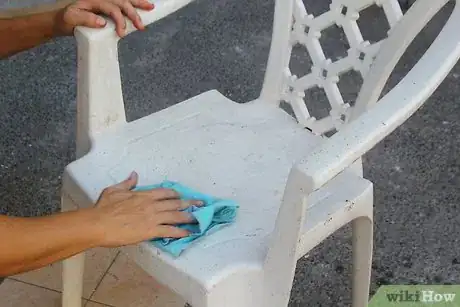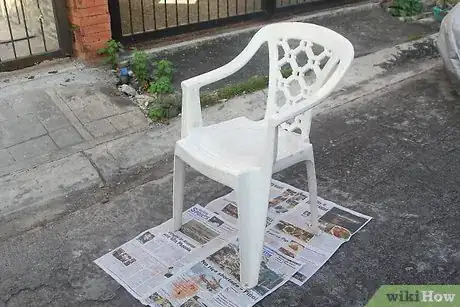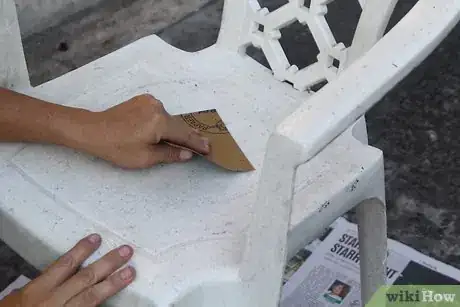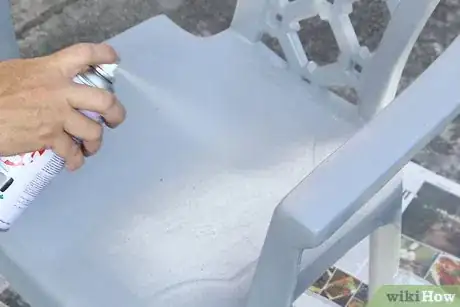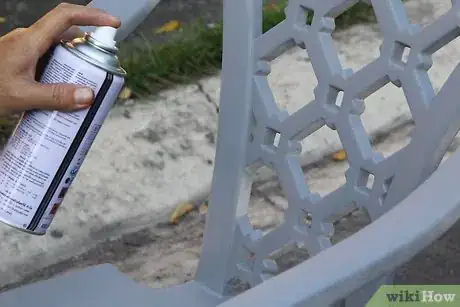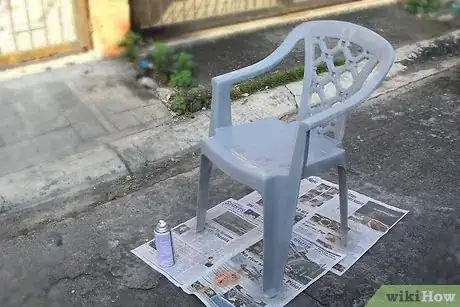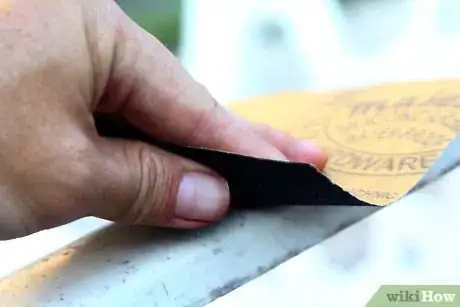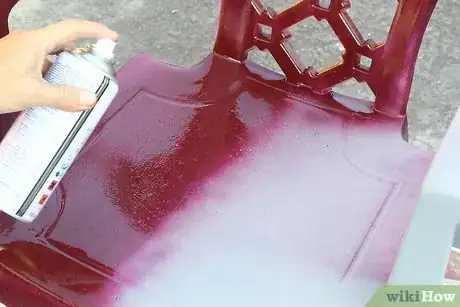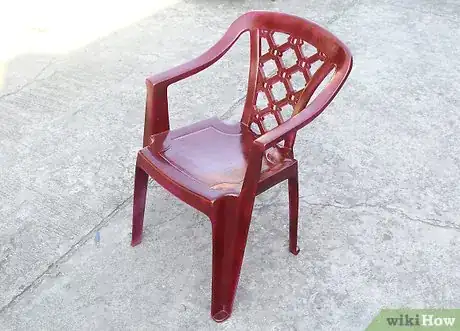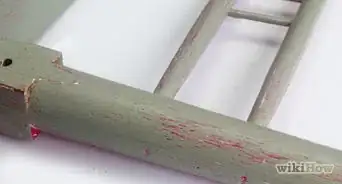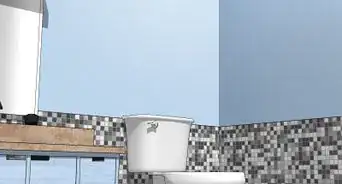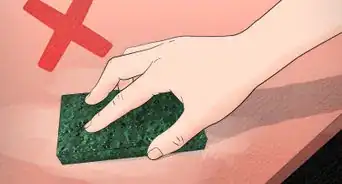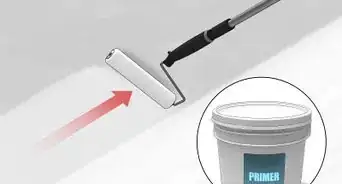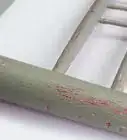This article was co-authored by Tanglewood Sue. Tanglewood Sue is a DIY and Upcycling Specialist and the Owner of Tanglewood Works out of Hyattsville, Maryland. With over nine years of experience, Sue specializes in upcycled painted furniture and other handmade, personalized, and sustainable goods. With her passion for art and reinvention, marketing experience, and Bachelor’s Degree in Broadcast Media, Sue has been able to create a business that not only provides quality pieces but empowers customers to create their works through her library of DIY tutorials and live demos as well as DIY supplies.
This article has been viewed 167,743 times.
Most plastic furniture can easily and safely be painted. Outdoor furniture such as plastic lawn chairs are especially easy to prepare and paint. Plastic furniture that will be used indoors can also be painted, but will require higher quality paint. Follow these steps, and you'll be resting on a freshly-painted plastic fashion statement in no time!
Steps
Preparing a Plastic Surface for Fresh Paint
-
1Clean the furniture. Fill a bucket with hot water. Add an ammonia-based cleaner to help remove mold or mildew on older furniture. Use a sponge to wash the entire surface of the piece you'll be painting. Spray the furniture with a hose. Use a pressurized nozzle attachment if you have one. Make sure to spray every surface of the furniture from multiple angles to ensure a complete rinse.[1]
- To clean brand new plastic, wipe down with a cloth soaked in paint thinner.
- An all-purpose cleaner, such as dish soap, will work if the furniture is not too dirty.
- Dry the furniture with a cotton towel and allow it to air dry completely. Ensure the furniture is completely dry before proceeding.
-
2Protect other surfaces. Choose an area with good ventilation to paint your furniture. A garage with the door open or a flat surface outdoors are ideal. Cover the surface of the ground with a material you don't mind dropping paint on, such as newspaper or a tarp. Use painter's tape to cover any surfaces of the furniture you do not wish to paint.
- For example, if you only want to paint the surface of a table, tape off the top portion of each leg.
Advertisement -
3Sand the furniture's surface. If the piece you're working on has been painted before, it will need to be lightly sanded. It is often worth sanding a bare plastic surface, as this will help primer and paint better adhere to the furniture. Use sandpaper or a sanding sponge with fine -grit to gently brush the entire surface.
- Test your sanding material in an inconspicuous spot on the furniture. Reduce pressure or use sanding equipment with a finer grit if any visible scratches appear.
- After sanding, wipe down the surface of the piece with a tack cloth to remove dust.[2]
- Skip to priming if the furniture is already smooth. Old furniture that has sat in the sun may be ready to paint after cleaning and drying. New plastic furniture will likely benefit from a light sanding.
- It is not compulsory to sand a piece before applying the new paint.
- You only need to make the surface a little rough to make the paint stick.
- The surface should be clean and not glossy.[3]
Priming and Painting Plastic Yard Furniture
-
1Consider priming the surface. Once the surface is clean, dry, and smooth, it's ready to prime. Though combination paint and primer sprays exist for use on plastic surfaces, use a primer if you wish to paint your furniture in a color of paint that is not available for plastic materials. Choose a primer designed to be used on plastic materials that are stored outdoors.
- These will be available at your local home improvement store, and will come in a spray can. Shake the can and spray the entire surface you intend to paint.
- Apply the primer in a steady back-and-forth motion while holding the can's nozzle 12-18in (30-45cm) from the surface.
-
2Apply a coat of spray paint. Use a combination paint and primer designed for use on plastic or prime the surface with a plastic-specific primer first. A satin finish is recommended for plastic surfaces. Hold the can upright, with the nozzle 12 in (30cm) from the surface. Evenly spray the entire surface in sweeping, back-and-forth motions.[4]
-
3Allow the first coat to fully dry. Once the paint is dry to the touch, assess whether you need another coat. This is up to you. If you used a paint and primer combo, you'll likely want to do at least one more coat. Once you're happy with the paint coverage, let the piece dry for 24 hours before use. Don't remove any painter's tape until the piece is completely dry!
Painting Plastic Furniture for Use Indoors
-
1Sand the furniture's surface. Prepare the surface of the furniture by washing it with warm water and an all-purpose cleaner. After rinsing and allowing it to dry, use fine grit sand paper to remove any visible scuffs in the plastic's surface. Sand the rest of the furniture's surface lightly, as this will help the primer adhere to the furniture.[5]
-
2Use latex-specific primer. Apply a full coat of a primer designed for use with latex paint. This will help ensure your paint adheres to the furniture you're painting. Since plastic does not hold paint as well as other materials, an adhesion primer is vital to make your top coat last.[6]
-
3Use 100% acrylic latex paint indoors. If you're painting a piece of furniture that will be kept inside your home, you'll want a paint that is less likely to release odor or gas. Further, paint of this type will be more resistant to stains and will be easier to clean than other option.[7]
- Go with either a satin or semi-gloss finish.
- This sort of paint will have more color options in liquid form. Ask someone at the paint counter of your local hardware store for a sample portion of whichever color you favor, as this will be especially cheap and will likely be enough to cover a plastic chair, for instance.
- Use a synthetic brush, or soak a bristle brush in water overnight before use.[8]
Community Q&A
-
QuestionWhat can be used to coat spray painted plastic furniture?
 T. ChinsenTop AnswererUse of spray paint specially designed for plastic will not require any extra protective coating. In general, a polyurethane or polyacrylic topcoat will protect the paint. Check the paint instructions to see which or what should be used as a topcoat. For the best results, use all of the same brand on your project. A mismatch can result in spotting or uneven texture due to different formulations of product.
T. ChinsenTop AnswererUse of spray paint specially designed for plastic will not require any extra protective coating. In general, a polyurethane or polyacrylic topcoat will protect the paint. Check the paint instructions to see which or what should be used as a topcoat. For the best results, use all of the same brand on your project. A mismatch can result in spotting or uneven texture due to different formulations of product.
Warning
- Wear safety glasses and dust mask when sanding, priming, or painting. If you're using spray paint, it is especially important to wear a dust mask.
References
- ↑ HTTP://WWW.KRYLON.COM/HOW-TO/HOW-TO-VIDEOS/HOW-TO-SPRAY-PAINT-PLASTIC-VIDEO/
- ↑ HTTP://WWW.KRYLON.COM/HOW-TO/HOW-TO-VIDEOS/HOW-TO-SPRAY-PAINT-PLASTIC-VIDEO/
- ↑ https://craftsbyamanda.com/tips-for-painting-on-plastic/
- ↑ https://www.rustoleum.com/product-catalog/consumer-brands/specialty/paint-for-plastic-spray
- ↑ http://www.valsparpaint.com/en/how-to/interior/special-challenges/plastic-and-laminate.html
- ↑ http://www.valsparpaint.com/en/how-to/interior/special-challenges/plastic-and-laminate.html
- ↑ http://www.valsparpaint.com/en/how-to/interior/special-challenges/plastic-and-laminate.html
- ↑ http://www.painting-ideas-and-techniques.com/acrylic-latex-paint.html
- Videos provided by The Weathered Door
About This Article
If you want to spruce up your plastic furniture with a fresh coat of paint, start by cleaning off any dirt and mildew with a mixture of hot water and an ammonia-based cleaner. Once your furniture is clean and rinsed, sand the surface with a piece of fine-grit sandpaper so the paint will stick better. Before you begin painting, make sure you are in a place that is well-ventilated, like a garage, and that any surfaces are covered with newspaper or a tarp. Then, apply a coat of primer designed for outdoor use. Once the primer has dried, evenly cover the furniture with a satin finish spray paint in the color of your choice and let it dry for 24 hours. For more tips, like how to paint plastic furniture that will be used indoors, scroll down.
